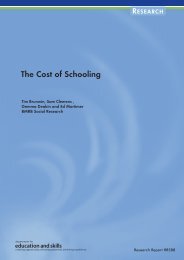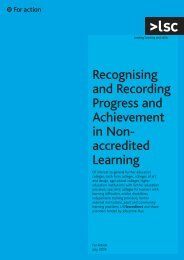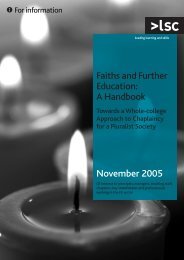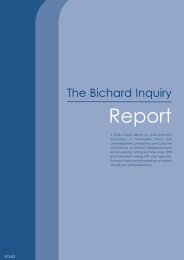Full Text (PDF) - Official Documents
Full Text (PDF) - Official Documents
Full Text (PDF) - Official Documents
Create successful ePaper yourself
Turn your PDF publications into a flip-book with our unique Google optimized e-Paper software.
Managing the expansion of the Academies Programme Part Three 37<br />
Oversight of academic performance<br />
3.18 The Office of the Schools Commissioner took over monitoring academies’<br />
academic performance from the YPLA in September 2011. Monitoring consists of:<br />
• analysis of academies’ performance against floor standards; 8<br />
• reviews of Ofsted ratings and exam trends; and<br />
• site visits and other intelligence, for example from local authorities.<br />
This information feeds into a risk rating, with red-rated schools receiving more detailed<br />
scrutiny and intervention.<br />
3.19 The proportion of academies which the Office of the Schools Commissioner<br />
considers high risk is very small. As at July 2012, the Office was monitoring the<br />
academic performance of 166 academies, and classified 30 of these as giving particular<br />
cause for concern.<br />
3.20 Figure 12 overleaf and Figure 13 on page 39 show academies’ most recent<br />
Ofsted grades as at July 2012 and their 2011/12 exam performance. Thirteen per cent<br />
of converters are assessed as satisfactory or inadequate by Ofsted, compared to<br />
49 per cent of sponsored academies. Sponsored academies’ exam performance is also<br />
relatively weaker. Both measures reflect the fact that the Department invited schools<br />
rated ‘outstanding’ (and later ‘good’) by Ofsted to convert first, whereas sponsored<br />
academies have been created from weaker schools.<br />
3.21 The Office of the Schools Commissioner relies chiefly on sponsor input – either<br />
from the existing sponsor or a new one – to rectify poor academy performance. As at<br />
September 2012, sponsors had replaced Principals at 22 academies where the Office<br />
of the Schools Commissioner considered poor leadership to have been impeding<br />
progress. The Office can issue notices to academies where it considers performance<br />
unacceptably low or sponsor improvement plans ineffective. To date, the Office has<br />
served eight ‘pre-warning notices’ and two full ‘warning notices.’<br />
8 In primary schools, the floor standard is 60 per cent of pupils at the end of Key Stage 2 achieving level 4 or above<br />
in English and maths, and national average percentage of pupils at the end of Key Stage 2 making expected<br />
progress in English and maths. In secondary schools, it is 40 per cent of pupils gaining five GCSEs A*–C (including<br />
English and maths). This will rise to 50 per cent by 2015.

















